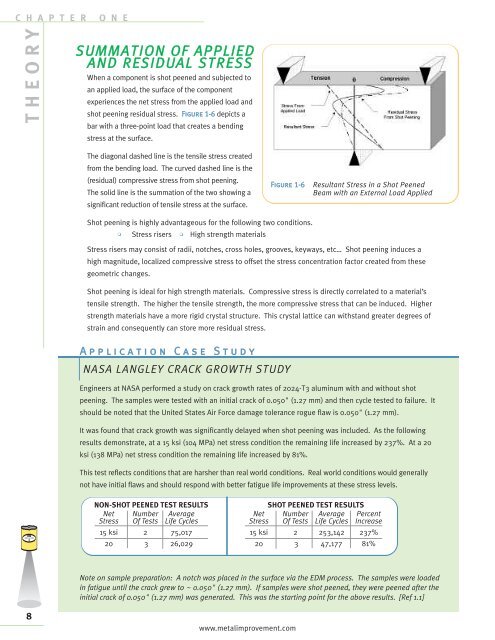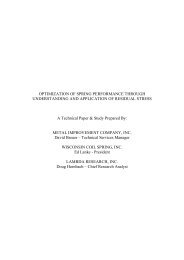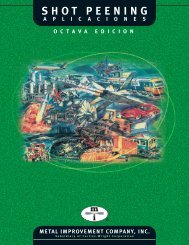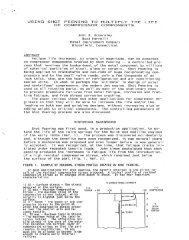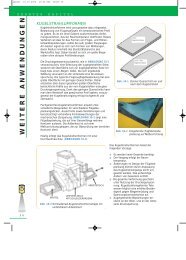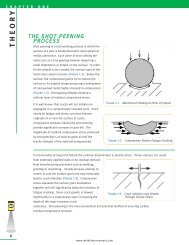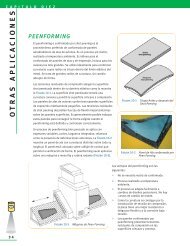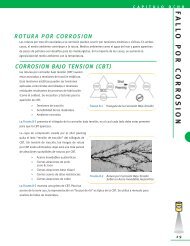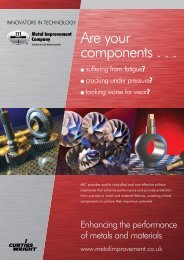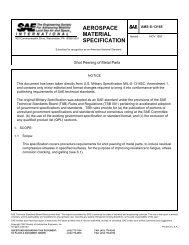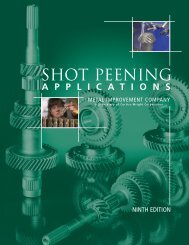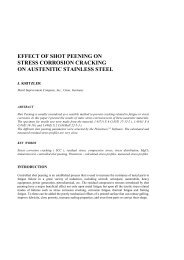shot peening residual stress - Metal Improvement Company
shot peening residual stress - Metal Improvement Company
shot peening residual stress - Metal Improvement Company
You also want an ePaper? Increase the reach of your titles
YUMPU automatically turns print PDFs into web optimized ePapers that Google loves.
C H A P T E R O N E<br />
THEORY<br />
8<br />
SUMMATION OF APPLIED<br />
AND RESIDUAL STRESS<br />
When a component is <strong>shot</strong> peened and subjected to<br />
an applied load, the surface of the component<br />
experiences the net <strong>stress</strong> from the applied load and<br />
<strong>shot</strong> <strong>peening</strong> <strong>residual</strong> <strong>stress</strong>. Figure 1-6 depicts a<br />
bar with a three-point load that creates a bending<br />
<strong>stress</strong> at the surface.<br />
The diagonal dashed line is the tensile <strong>stress</strong> created<br />
from the bending load. The curved dashed line is the<br />
(<strong>residual</strong>) compressive <strong>stress</strong> from <strong>shot</strong> <strong>peening</strong>.<br />
The solid line is the summation of the two showing a<br />
significant reduction of tensile <strong>stress</strong> at the surface.<br />
Shot <strong>peening</strong> is highly advantageous for the following two conditions.<br />
• Stress risers • High strength materials<br />
Stress risers may consist of radii, notches, cross holes, grooves, keyways, etc… Shot <strong>peening</strong> induces a<br />
high magnitude, localized compressive <strong>stress</strong> to offset the <strong>stress</strong> concentration factor created from these<br />
geometric changes.<br />
Shot <strong>peening</strong> is ideal for high strength materials. Compressive <strong>stress</strong> is directly correlated to a material’s<br />
tensile strength. The higher the tensile strength, the more compressive <strong>stress</strong> that can be induced. Higher<br />
strength materials have a more rigid crystal structure. This crystal lattice can withstand greater degrees of<br />
strain and consequently can store more <strong>residual</strong> <strong>stress</strong>.<br />
A p p l i c a t i o n C a s e S t u d y<br />
NASA LANGLEY CRACK GROWTH STUDY<br />
Engineers at NASA performed a study on crack growth rates of 2024-T3 aluminum with and without <strong>shot</strong><br />
<strong>peening</strong>. The samples were tested with an initial crack of 0.050" (1.27 mm) and then cycle tested to failure. It<br />
should be noted that the United States Air Force damage tolerance rogue flaw is 0.050" (1.27 mm).<br />
It was found that crack growth was significantly delayed when <strong>shot</strong> <strong>peening</strong> was included. As the following<br />
results demonstrate, at a 15 ksi (104 MPa) net <strong>stress</strong> condition the remaining life increased by 237%. At a 20<br />
ksi (138 MPa) net <strong>stress</strong> condition the remaining life increased by 81%.<br />
This test reflects conditions that are harsher than real world conditions. Real world conditions would generally<br />
not have initial flaws and should respond with better fatigue life improvements at these <strong>stress</strong> levels.<br />
NON-SHOT PEENED TEST RESULTS<br />
Net Number Average<br />
Stress Of Tests Life Cycles<br />
15 ksi 2 75,017<br />
20 3 26,029<br />
Note on sample preparation: A notch was placed in the surface via the EDM process. The samples were loaded<br />
in fatigue until the crack grew to ~ 0.050" (1.27 mm). If samples were <strong>shot</strong> peened, they were peened after the<br />
initial crack of 0.050" (1.27 mm) was generated. This was the starting point for the above results. [Ref 1.1]<br />
www.metalimprovement.com<br />
Figure 1-6 Resultant Stress in a Shot Peened<br />
Beam with an External Load Applied<br />
SHOT PEENED TEST RESULTS<br />
Net Number Average Percent<br />
Stress Of Tests Life Cycles Increase<br />
15 ksi 2 253,142 237%<br />
20 3 47,177 81%


